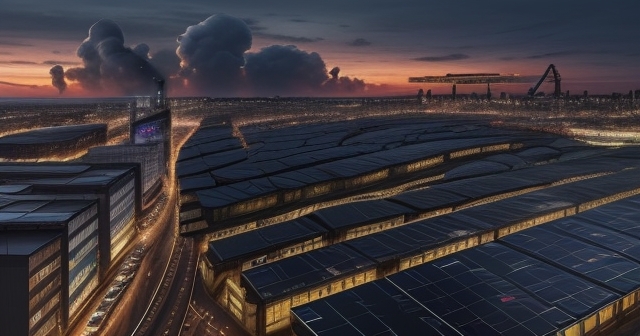Navigating the Tides: A Deep Dive into UK Commodity Trading in a Shifting Global Landscape
Welcome, aspiring and experienced traders alike, to a comprehensive exploration of the dynamic world of commodity trading UK. The landscape for those involved in, or considering engaging with, this vital sector is constantly evolving, shaped by a complex interplay of domestic policy shifts, global market dynamics, geopolitical tremors, and the inexorable push towards a greener future. For us to truly understand the opportunities and risks, we must look beyond simple price charts and delve into the fundamental forces at play.
Think of it like learning to sail. You need to know your boat (your trading platform and strategy), but you also need to understand the currents (global economic trends), the winds (supply and demand), the weather forecast (geopolitics and policy), and even the local harbour conditions (UK specific factors). Today, we’ll examine some of the most significant factors currently influencing the UK commodity market, breaking down complex issues into understandable insights.
The UK, despite its relatively small size on the global stage compared to giants like the US or China, plays a crucial role in commodity markets, both as a consumer, producer (of some resources like North Sea oil and gas), and a major trading hub. Understanding these connections is key to successful commodity trading UK.

Here are some key considerations for navigating the UK commodity market:
- Understanding the impact of global economic trends.
- The importance of policy shifts on market dynamics.
- Identifying specific demands for commodities influenced by technological advancements.
Tariff Triumphs and Trade Realignment: A Closer Look at UK Steel and Aluminum
Let’s start with a piece of positive news for certain sectors within the UK. A significant development we’ve seen recently is the bilateral trade agreement between the UK and the US, leading to the removal of the 25% import tariffs on UK steel and aluminum that were imposed several years ago. For industries that rely heavily on exports, like the UK’s steel and aluminum producers, this is a welcome relief.
These tariffs had been a substantial barrier, adding significant cost and complexity to sending UK-produced metals across the Atlantic. Historically, the US has been a meaningful market for UK metal exports, accounting for around 7% of UK steel exports and about 3% of aluminum exports. Removing this hurdle is expected to provide a tangible boost to these figures, opening up greater access to a major economy.
For those trading in metal commodities or related stocks, understanding the impact of such trade agreements is vital. Increased export potential can influence production levels, pricing strategies, and overall market sentiment for companies in this sector. It’s a clear example of how targeted policy interventions can directly affect specific segments of the UK commodity market.

Beyond Tariff Relief: Persistent Headwinds for UK Metals Industries
While the removal of US tariffs is undoubtedly good news, it’s crucial not to view it as a silver bullet for the UK metals industries. The reality is that sectors like UK Steel and aluminum still face formidable challenges that temper the optimism generated by the trade agreement. When we analyze the health of these industries, we see a confluence of factors creating persistent headwinds.
One major challenge is **global overcapacity**. Many countries have built significant production capacity for steel and aluminum, often exceeding global demand. This oversupply puts downward pressure on international prices, making it difficult for UK producers, who often have higher operating costs, to compete effectively on price alone. It’s like trying to sell your produce in a market flooded with identical goods – you have less power to command a premium.

Another significant hurdle is **high energy costs**. Manufacturing metals is an energy-intensive process, and energy prices in the UK have been volatile and often significantly higher than in some competitor nations. These elevated costs feed directly into production expenses, eroding margins and making UK output less competitive globally. Imagine trying to run a power-hungry factory when electricity prices are through the roof – it directly impacts your bottom line.
Furthermore, **weak demand**, both domestically and in key international markets (excluding the US boost), continues to be a drag. Construction, automotive, and other sectors that are major consumers of steel and aluminum have faced slowdowns, reducing the overall need for these materials. Low demand combined with high costs and global oversupply creates a tough operating environment.
We also see specific challenges within the UK aluminum sector, particularly concerning recycling. The UK aims to boost its circular economy and decarbonisation efforts by increasing domestic aluminum recycling. However, high demand for aluminum scrap from countries like the US, driven in part by their own manufacturing needs, leads to significant “scrap leakage” from the UK. This means valuable scrap that could be recycled domestically is exported, hindering UK efforts to build a robust domestic recycling loop. Understanding these intricate supply chain dynamics is part of mastering commodity trading UK.
The North Sea Dilemma: Policy Proposals vs. The Future of UK Energy Investment
Shifting our focus to energy, a major point of discussion impacting the future of UK oil and gas production revolves around potential changes in taxation. The Labour Party has proposed increasing the tax rate on North Sea oil and gas profits. This policy aims to capture more revenue from energy companies operating in UK waters, particularly during periods of high commodity prices.
While the intention might be to boost public finances or fund energy transition initiatives, the oil and gas industry itself has issued strong warnings about the potential consequences. Industry representatives argue that significantly increasing taxes could **kill investment** in the North Sea. Why would companies commit billions of pounds to develop new fields or maintain existing infrastructure if a large portion of the potential profit is immediately taxed away?
For those involved in energy commodity trading UK or considering investments in UK-listed energy companies, this is a critical factor. Reduced investment could lead to declining production over time, impacting the UK’s energy security and potentially increasing reliance on imports. It also affects the long-term supply outlook for North Sea Brent crude, a key benchmark in global oil prices. Understanding the interplay between government policy, industry response, and production forecasts is essential here.

The debate highlights a fundamental tension: the desire to extract more revenue from current fossil fuel production versus the need to encourage investment in both continued conventional energy supply (for security during the transition) and new technologies like carbon capture or hydrogen, which often rely on existing energy infrastructure and expertise. This is a complex policy landscape with direct implications for the future supply side of the UK commodity market.
Global Energy Dynamics: Oil, Gas, and Future Forecasts Influencing UK Trading
While North Sea policy is a UK-specific issue, the broader energy markets are profoundly global, and what happens elsewhere significantly impacts commodity trading UK. Oil prices, in particular, are a constant focus, driven by a multitude of factors ranging from weather events to international diplomacy and long-term structural shifts.
We’ve seen how events like major US hurricanes (e.g., Ida impacting Gulf of Mexico production) can cause temporary price spikes by disrupting supply. OPEC+ decisions on production levels continue to exert significant influence, acting as a major supply-side management force. Geopolitical tensions, such as hopes for truces or ongoing conflicts (like the war in Ukraine and its impact on Russian supply), constantly add volatility to prices. Even US strategic petroleum reserve (SPR) policy, like potential releases, can momentarily affect the supply-demand balance and prices.
But beyond these near-term fluctuations, major bodies like the International Energy Agency (IEA) are providing long-term forecasts that demand our attention. The IEA, for instance, has predicted a **significant global oil glut by 2030**. This forecast is based on projections of slowing demand growth (driven by energy efficiency and the rise of EVs) coupled with continued non-OPEC+ supply increases. If this forecast proves accurate, it suggests a fundamental shift in the oil market over the coming years, potentially leading to sustained lower prices or greater volatility as producers compete for market share.
This long-term outlook is crucial for anyone involved in commodity trading UK, particularly in energy derivatives or related equities. It suggests that while short-term trading opportunities based on supply disruptions or geopolitical news will persist, the structural trend might be towards oversupply, presenting challenges for traditional oil and gas investments but potentially benefiting consumers and industries reliant on energy inputs.

Natural gas and LNG markets are similarly complex, affected by regional supply issues, pipeline politics, and the increasing global trade in liquefied natural gas. UK gas prices are closely linked to European hubs, and events like disruptions to Russian gas supply or increased demand for LNG in Asia can have ripple effects that impact energy costs and trading opportunities here.
The Green Imperative: Commodities Fueling the Energy Transition
Perhaps one of the most significant structural shifts impacting commodity trading UK and globally is the accelerating energy transition. The global move away from fossil fuels towards renewable energy sources and electrification is creating massive new demand for specific raw materials. This isn’t just an environmental movement; it’s fundamentally reshaping commodity markets.
Building wind turbines, solar panels, electricity grids capable of handling distributed renewable power, and especially electric vehicles (EVs) requires vast quantities of certain metals. We’re talking about copper for wiring and motors, aluminum for lightweight structures, rare earth elements for magnets in motors and generators, and, perhaps most prominently in recent discussions, lithium and other battery metals like cobalt and nickel for energy storage.
This surge in demand is putting immense pressure on mining and processing industries. Existing mines need to increase output, and new deposits need to be discovered and developed. The scale of the required increase in production for some of these metals is staggering when viewed through the lens of ambitious decarbonisation targets. This creates opportunities but also significant challenges for supply chains and pricing.

For traders, this means that traditionally less-followed metals are becoming critically important. The price movements of lithium, cobalt, nickel, and specific types of copper or rare earths are increasingly relevant to industries investing in the green transition, including those in the UK involved in EV manufacturing or renewable energy projects. Understanding the future demand curves driven by policy targets and technological adoption is key to navigating this part of the commodity market.
Metals of the Future: Lithium, Copper, and Supply Chain Challenges
Let’s delve deeper into the specific metals driving the energy transition. **Lithium**, often referred to as “white gold,” is essential for the lithium-ion batteries that power EVs and grid-scale energy storage. Demand is projected to soar in the coming years, creating a global race to secure supply. We’ve seen companies like Eramet developing lithium plants in Argentina and major miners like Rio Tinto pushing forward with projects like the Jadar lithium mine in Serbia (though facing local opposition), specifically to feed the growing European EV industry. Even in the UK, there are efforts, such as a miner raising funds to search for metals, including lithium, in Cornwall, hinting at the potential for domestic supply, however small scale initially.
**Copper** is another critical metal, fundamental to the entire electrification process. EVs use significantly more copper than internal combustion engine cars. Expanding electricity grids to handle renewable energy and charge EVs requires miles of copper wiring. Decarbonising industries, including using hydrogen (which requires electrolysers often containing copper), also increases demand. Production issues at major copper mines, such as those Codelco has faced in Chile, highlight how supply disruptions can quickly impact prices globally. The global push for electrification means copper demand is set to remain strong, making it a key metal for commodity trading UK and worldwide.
The challenge with these metals isn’t just increasing mining output; it’s also building the refining and processing capacity, often concentrated in specific regions like China, and ensuring environmentally and socially responsible extraction. Supply chain vulnerabilities are a major concern for manufacturers in countries like the UK who rely on these inputs for their green technology sectors (e.g., SMMT representing the automotive industry would be closely watching these supply lines).
For traders, this means paying close attention to mining company news, production reports, and geopolitical stability in key producing regions. The **prices** of these metals are likely to remain volatile, sensitive to both supply-side issues and the pace of the energy transition. This is where deep research into specific market dynamics pays off in commodity trading UK.
Agriculture Under Pressure: Climate, Policy, and Food Security
Commodity trading isn’t limited to energy and metals; agricultural commodities are also a significant part of the landscape, directly impacting food prices and security, even in the UK. Global agricultural markets are highly sensitive to weather patterns, climate change effects, and government policies, which can create significant price volatility and trading opportunities.
We’ve seen recent examples of how climate events directly impact production. Record rainfall in the UK and France, for instance, has negatively impacted wheat crops, affecting both the yield and quality of the harvest. This kind of weather event reduces local supply, which can support domestic prices or require increased imports, influencing commodity trading UK markets for grains.
Beyond local weather, global factors like export bans can cause dramatic price spikes. India’s decision to ban certain rice exports, for example, had a ripple effect across global grain markets, highlighting how policy decisions in major producing nations can disrupt international supply and inflate prices for key foodstuffs like rice, wheat, and corn. China’s continued strong demand for feed grains like corn also remains a significant driver of global agricultural commodity prices.
For traders focusing on agricultural commodities, understanding not just historical price trends but also current weather forecasts, crop reports, and agricultural policies in major producing and consuming countries is paramount. The increasing frequency of extreme weather events linked to climate change adds another layer of complexity and potential volatility to these markets. These are essential elements to consider when approaching this segment of commodity trading UK.
The Geopolitical Chessboard: Sanctions, Conflicts, and Market Impact
Geopolitics is an unavoidable force in commodity markets. Conflicts, political instability, and international sanctions regimes can disrupt supply lines, alter trading routes, and fundamentally change market dynamics, often very rapidly. For anyone involved in commodity trading UK, keeping a close watch on global political developments is non-negotiable.
A prime example is the impact of sanctions against Russia following its invasion of Ukraine. While direct trade might be curtailed, the effects ripple through global markets. The UK, for instance, has imposed sanctions on a Russian insurer of the “shadow fleet” – the network of ships operating outside traditional insurance and regulatory frameworks to transport Russian oil. This move aims to make it harder and more expensive for Russia to export its oil, thereby limiting its revenues.
Such actions demonstrate how financial sanctions and targeting specific services (like insurance) can be used as tools to influence commodity flows and prices. They create uncertainty about supply, potentially leading to higher prices for alternative sources or increased costs for buyers who rely on the affected supply. This is a complex area, often involving tracking ship movements, understanding insurance markets, and analyzing policy compliance.
Geopolitical tensions also influence energy infrastructure (like gas pipelines), mining operations in unstable regions, and agricultural exports from conflict zones. The potential for sudden shifts in supply or demand due to political events makes geopolitical analysis a crucial skill for effective commodity trading UK, especially in energy and certain metals.
Navigating Market Sentiment and the Role of Trading Hubs
Beyond the fundamental forces of supply, demand, policy, and geopolitics, market sentiment plays a significant role in short-to-medium term price movements in commodity trading UK and worldwide. How traders and investors *feel* about the market outlook, their risk appetite, and their reactions to news events can create trends that deviate from fundamentals, at least temporarily.
We’ve seen examples of this with assets like gold, which often acts as a safe haven during times of economic uncertainty or geopolitical turmoil. When fears of recession rise, demand for gold tends to increase, pushing up its price. Conversely, periods of optimism or “risk-on” sentiment can see investors move away from safe havens towards assets perceived to offer higher growth potential.
At times, we’ve even seen sentiment driven by retail trading frenzies, such as the surge in silver prices fueled by online forums several years ago. While such events are often short-lived and decoupled from fundamental supply and demand, they underscore the influence that collective market psychology can have, especially in certain markets. Understanding market sentiment involves monitoring news flow, social media trends (with caution!), and trading volumes.
Major trading hubs like the London Metal Exchange (LME) also play a vital role in setting global benchmark prices for key industrial metals. The integrity and smooth functioning of these exchanges are crucial for the entire commodity ecosystem. Issues of governance, clearing processes, and even the historical culture of the exchange (like the LME working to shed past sexist images associated with its annual gatherings) can impact market confidence and functionality. For anyone actively engaged in commodity trading UK, particularly in metals, understanding the mechanics and reputation of the LME is fundamental.
Key Data Points and Indicators for the UK Trader
To effectively navigate the complex landscape of commodity trading UK, you need to be equipped with the right data and understand key indicators. While this article focuses on fundamentals, monitoring market data is essential for timing and execution.
You’ll want to keep an eye on commodity-specific data:
- Production reports (e.g., OPEC output, mining company quarterly reports)
- Inventory levels (e.g., crude oil stockpiles in the US and elsewhere, LME warehouse stocks)
- Demand indicators (e.g., manufacturing PMIs, auto sales figures, construction spending)
- Trade flows (e.g., export/import data from major countries)
- Weather forecasts and crop reports for agricultural commodities
Beyond commodity specifics, broader macroeconomic indicators are also crucial, as they influence overall demand and market sentiment:
- **Inflation data:** Impacts purchasing power and potentially central bank actions on interest rates, which in turn affect economic growth and demand for raw materials.
- **Economic growth data (GDP):** Strong growth typically means higher industrial activity and consumer demand, boosting demand for commodities.
- **Interest rates:** Higher rates can slow economic growth and potentially dampen demand, while lower rates can stimulate activity.
- **Currency movements:** Exchange rates affect the cost of commodities priced in US dollars for buyers using other currencies (like GBP for commodity trading UK), influencing demand.
- **Stock market performance:** Major indices (FTSE 100, S&P 500, etc.) can sometimes act as a proxy for broader economic confidence, which correlates with commodity demand.
Monitoring these data points helps build a more complete picture of the forces influencing the markets you trade. It allows you to move from a general understanding to specific, actionable insights for your commodity trading UK activities.
Conclusion: Charting the Course in Complex Commodity Markets
As we’ve explored, the world of commodity trading UK is a fascinating, intricate space where local policy, global economics, technological innovation, and geopolitical events converge. From the specific relief offered by the US tariff removal for UK metals producers to the existential questions facing North Sea oil and gas investment, and the transformative demand created by the energy transition, there are layers upon layers of complexity to understand.
Navigating these markets successfully requires more than just following price charts. It demands an understanding of the fundamental drivers of supply and demand, an awareness of the policy and political decisions that can shift dynamics, and the ability to factor in unpredictable events like extreme weather or geopolitical conflict. It’s about being a perpetual student, constantly learning and adapting.
Whether you are a new trader just starting to explore commodities or an experienced hand looking to refine your strategy, the principles remain the same: knowledge is your greatest asset. By staying informed about the key trends we’ve discussed – from trade agreements and tax debates to the demand for lithium and the impact of sanctions – you position yourself to make more informed decisions in your commodity trading UK journey.
We encourage you to continue researching, to delve deeper into the specific commodities that interest you, and to understand the unique factors that influence their markets. The commodity landscape is always changing, presenting both challenges and compelling opportunities for those who are prepared to understand its depths.
| Commodity | Current Price | Market Trend |
|---|---|---|
| Crude Oil | $80 | Stable |
| Gold | $1,900 | Increasing |
| Lithium | $18,000 | Rising |
| Major Challenges | Potential Solutions |
|---|---|
| High Energy Costs | Invest in renewable energy |
| Global Overcapacity | Reduce production in excess |
| Weak Demand | Enhance marketing strategies |
| Indicators | Description |
|---|---|
| Production Reports | Details on output from major producers |
| Inflation Rates | Trends that affect purchasing power |
| Currency Movements | Exchange rate fluctuations impacting costs |
commodity trading ukFAQ
Q:What is the current outlook for UK commodity trading?
A:The outlook remains complex, influenced by global demand, policy changes, and market sentiment.
Q:Which commodities are currently in high demand?
A:Lithium, copper, and renewable energy materials are among the most sought after.
Q:How do geopolitical events affect commodity prices?
A:They can disrupt supply chains and alter trade routes, impacting prices globally.

留言